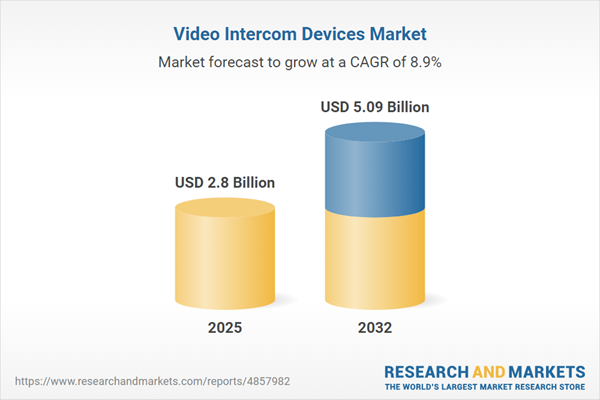Speak directly to the analyst to clarify any post sales queries you may have.
The Video Intercom Devices Market is rapidly transforming modern security and communications, delivering crucial solutions for visual and audio identification across key sectors. As organizations seek advanced methods to manage secure entry and seamless interaction, the adoption of agile, intelligent video intercom technology is accelerating globally.
Market Snapshot: Video Intercom Devices Market Growth and Opportunity
The Video Intercom Devices Market grew from USD 2.57 billion in 2024 to USD 2.80 billion in 2025. It is expected to continue growing at a CAGR of 8.93%, reaching USD 5.09 billion by 2032. This robust outlook reflects escalating demand across residential, commercial, and industrial environments, driven by the need for integrated security and user-centric access management. Video intercom device adoption is widespread, with strategic technology investments fueling the convergence of surveillance, access control, and communication functions.
Scope & Segmentation: Unlocking Comprehensive Market Insights
- Device Types: Wired (including Non PoE and PoE) and Wireless (RF and Wi-Fi) devices form the backbone of solution portfolios, catering to a range of installation and connectivity needs.
- Connectivity Modalities: Incorporates Analog (Coaxial, Twisted Pair) and IP-based systems (DHCP, Static IP) to address diverse deployment scenarios and integration preferences.
- End User Segments: Commercial (Hospitality, Office, Retail), Industrial (Healthcare, Manufacturing, Transportation), and Residential markets, supporting broad adoption patterns and unique operational requirements.
- Installation Options: Flush Mount and Surface Mount formats allow for discreet integration or rapid, flexible deployment, respectively.
- Distribution Channels: Offline pathways (Direct Sales, Distributors, Retailers) alongside digital channels (E-Commerce, OEM Portals) deliver tailored procurement journeys.
- Applications: Solutions span Access Control Integration and Door Entry, central to authentication and visitor management.
- Regional Analysis: The report evaluates pivotal market activity across the Americas (North America, Latin America), Europe, Middle East & Africa (Europe, Middle East, Africa), and Asia-Pacific, examining trends and local ecosystem developments.
- Key Industry Players: Strategic moves from global organizations such as Hangzhou Hikvision Digital Technology, Zhejiang Dahua, Aiphone Corporation, Comelit Group, Samsung Electronics, Hanwha Techwin, Legrand, Axis Communications, Zenitel, and 2N Telekomunikace are analyzed in depth.
Key Takeaways for Senior Leaders
- User expectations are driving evolution towards intuitive designs, touchless interfaces, and seamless mobile applications that reduce training time and support proactive engagement.
- Integration of artificial intelligence and advanced analytics elevates situational awareness, aiding in early threat detection and operational efficiency without compromising user accountability.
- Hybrid deployments, which combine edge computing and centralized analytics, help organizations manage data sovereignty and real-time responsiveness, especially as regulatory demands intensify.
- Collaboration between security integrators and technology vendors is streamlining bundled solutions, making procurement and maintenance more manageable for end users.
- Supply chain agility, reinforced by dual sourcing and regional assembly capabilities, is critical to mitigating tariff impacts and disruptions.
Tariff Impact and Strategic Adjustments
Recent United States tariffs on core electronic components are elevating costs for global video intercom supply chains. As a result, procurement teams are seeking alternate sourcing options and accelerating production localization. Industry responses include the recalibration of inventory strategies and negotiation of value-added partnerships to offset transitional cost pressures. The evolving tariff environment is reshaping pricing models, vendor relationships, and end-user contracts throughout the ecosystem.
Methodology & Data Sources
This report integrates qualitative and quantitative research approaches. Primary source contributions include structured interviews with senior executives, end users, systems integrators, and independent consultants. Findings are rigorously validated against secondary sources, such as market publications and regulatory filings. Analytical frameworks including SWOT and PESTLE provide robust context, while expert review and triangulation enhance data reliability.
Why This Report Matters for Strategic Decision-Makers
- Empowers leaders to identify scalable growth, risk mitigation, and investment priorities in a rapidly changing security technology landscape.
- Provides actionable segmentation and competitive intelligence across regions, technologies, and distribution models essential for long-term value creation.
- Delivers insights to navigate policy shifts, tech innovations, and evolving customer expectations, equipping stakeholders for resilient decision-making.
Conclusion
The Video Intercom Devices Market is being reshaped by technology convergence, regional trends, and regulatory developments. This report offers strategic clarity for organizations seeking to drive operational efficiency, enhance security integration, and sustain competitive positioning within the global video intercom landscape.
Additional Product Information:
- Purchase of this report includes 1 year online access with quarterly updates.
- This report can be updated on request. Please contact our Customer Experience team using the Ask a Question widget on our website.
Table of Contents
3. Executive Summary
4. Market Overview
7. Cumulative Impact of Artificial Intelligence 2025
Companies Mentioned
The companies profiled in this Video Intercom Devices market report include:- Hangzhou Hikvision Digital Technology Co., Ltd.
- Zhejiang Dahua Technology Co., Ltd.
- Aiphone Corporation
- Comelit Group S.p.A.
- Samsung Electronics Co., Ltd.
- Hanwha Techwin Co., Ltd.
- Legrand SA
- Axis Communications AB
- Zenitel ASA
- 2N Telekomunikace a.s.
Table Information
| Report Attribute | Details |
|---|---|
| No. of Pages | 180 |
| Published | October 2025 |
| Forecast Period | 2025 - 2032 |
| Estimated Market Value ( USD | $ 2.8 Billion |
| Forecasted Market Value ( USD | $ 5.09 Billion |
| Compound Annual Growth Rate | 8.9% |
| Regions Covered | Global |
| No. of Companies Mentioned | 11 |









